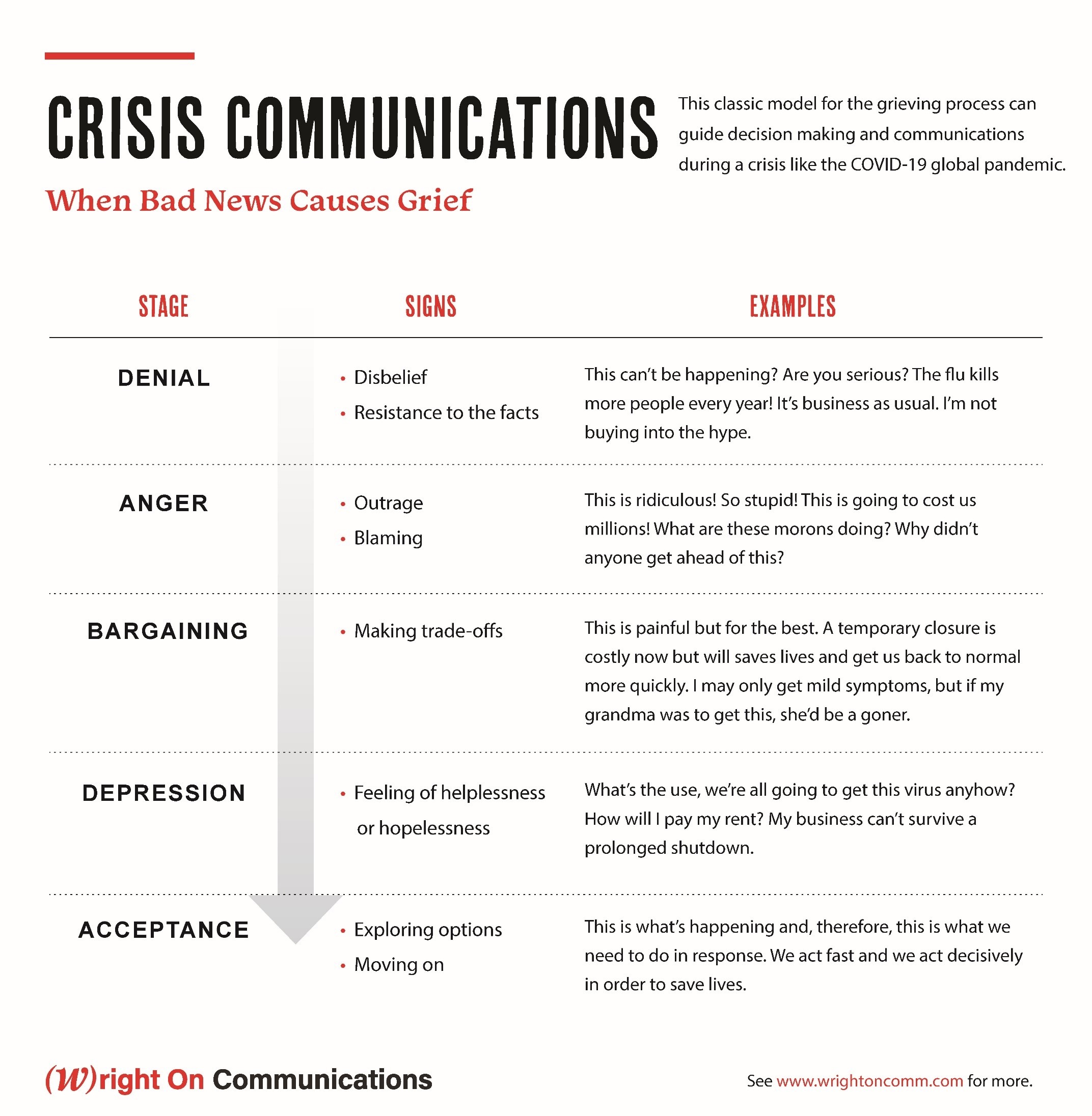How to identify the stages of grief in COVID-19 messages
As organizations work through their anger, fear and denial around the economic disruption and health impacts of coronavirus, it’s helpful to use the Kübler-Ross model.

Editor’s note: This article is a re-run as part of our countdown of top stories from the past year.
It is definitely not business as usual in the U.S., with travel restrictions, event postponements, closures, runs on toilet paper—and time is not on our side. We need millions of people to change their fundamental beliefs, attitudes and behaviors, stat!
I’ve found it useful in past crises, and especially helpful in the current COVID-19 crisis, to apply elements of the grief model when guiding clients.
It also works as a way to take my own emotional pulse when confronted by terrible news and as a framework for identifying public mindsets, too.
The five stages of grief
Anyone who took a 100-level psychology course in college knows about the Kübler-Ross model which outlines five stages of grief:
- Denial
- Anger
- Bargaining
- Depression
- Acceptance
The faster you as a communicator work through these five stages (particularly the first three) and get to acceptance, the better you can counsel your clients or executives to move them towards action. You can also think of your role as helping your publics—whether that means employees, customers, parents, students, patients, residents or citizens—through this process.
People must get to acceptance in order to adopt the beliefs and attitudes that will lead to the behavior changes needed to fight COVID-19 and flatten the curve. Those include social distancing, staying home if sick (or just staying home, in general) and calling health providers instead of presenting at the ER with milder symptoms.
Here’s how to spot where someone is in the grieving process—including yourself:

Stage 1: Denial
This stage manifests with statements of disbelief or challenges to given facts.
These kinds of comments and reactions on social media have appeared even as the disease was escalating in Korea and Iran, and then in Italy last week. St. Patrick’s Day revelers in the bars this past weekend were another example of a target demographic in denial.
If people weren’t reading the news reports from other countries or educating themselves on the exponential infection rate (for every new person with COVID-19, two more get sick), then they couldn’t understand the basic progression of the disease:
Making decisions without confronting the real implications of this exponential growth curve (and doing the math on numbers of hospital beds, ICU beds, ventilators and healthcare providers) leads to situations like what happened in Italy and, most likely, will happen in the U.S.
Communicators and other advisors must ensure that decision makers have the facts and, more importantly, face the facts, and help their stakeholders understand them too.
Stage 2: Anger
Once someone realizes that the bad news is real, the next response is often anger. Making decisions from a place of anger isn’t optimal. It leads to defiance or half measures.
Another outcome in this stage can be a passive-aggressive response where leaders don’t communicate or get angry when their advisors present them with important information—”shooting the messenger.” Some members of the public might get angry with the media or the many brand managers sending emails with information on their pandemic-related policies and precautions.
Stage 3: Bargaining
Bargaining is a more constructive stage. It’s the turning point. During this stage, people start to gain some perspective and consider the wider implications, characterized by trade-offs.
It can take a while to get to this level of reflection where a level-headed cost-benefit assessment can be made, but this is necessary for good decision making.
Stages 4 and 5: Depression and Acceptance
It’s hard to avoid feeling glum about the immediate future as you look at your options in a crisis like COVID-19.
Postponed multi-million-dollar events, cancelled shifts, restricted travel, mass telecommuting are just some of the evidence of the disrupted economy and looming recession. The important thing is not to wallow or get stuck in that stage. The sooner you and your leaders can get to the “acceptance” stage, the better equipped you will be to make the right decisions.
Once decision makers get to “acceptance” and start implementing the restrictions needed to keep people as safe as possible, the communicator’s next job is ensuring that affected stakeholders move through the stages too.
There are many other emotional factors that affect the public’s decision making (fear and anxiety top that list), but showing the public that this is an informed decision and that it is driven by a concern for their health and wellbeing and that of their loved ones or community will help leaders provide comfort and confidence when they’re most needed.
Leaders who don’t base their decisions on what’s best for their stakeholders, and instead base their decisions on what’s best for themselves, could find themselves also grieving a job when this crisis is over.
Julie Wright is president and founder of (W)right On Communications, Inc., a strategic communications firm with offices in Los Angeles, San Diego and Vancouver. Follow her on Twitter @juliewright. For a PDF of this graphic, visit her website.







Thank you for one of the best articles I have seen in this subject.
Mary Ellen, Thank YOU for the feedback! I hope people find it useful. Be safe and stay well! – Julie
Just the article I was looking for to pass onto my University colleagues. Thank you!
Glad you found it useful, Laurie!
Thank you for this article and I wonder if there is any follow up on that same line of thinking? Is there any book you would recommend to read around that?
You can read more about the Stages of Grief in “On Grief and Grieving.” For crisis communications information, Check out our Crisis Daily newsletter!
Since publishing this article, I’ve heard from a number of people who found it helpful and who shared similar content with me.
Here’s an article on higher ed’s ‘denial’ about the longer term impacts of coronavirus on their business models:
https://wallyboston.com/transformation-long-game-higher-education/
And here’s a podcast about grieving and that the road to recovery is found in ‘purpose.’ I think that should be a follow up post as we communicators start turning our messaging the future:
David Kessler talks to Brene Brown on grief and purpose:
https://brenebrown.com/podcast/david-kessler-and-brene-on-grief-and-finding-meaning/
I feel like that by now the stages are reverting again, everybody was pretty accepting up until January. Now everyone is in either denial or angry again…